The automotive spark plug market is estimated at USD 4.6 billion in 2025 and is forecast to reach USD 6.9 billion by 2035, reflecting a CAGR of 4.2%. Analyzing the price evolution and average selling price (ASP) trends, the market demonstrates a gradual and steady increase in value over the forecast period. The incremental annual growth from USD 4.6 billion in 2025 to USD 6.9 billion in 2035 suggests modest price appreciation aligned with incremental technology improvements, manufacturing efficiency gains, and gradual expansion of automotive production globally.
The ASP is influenced by shifts in spark plug technology, including the adoption of iridium and platinum-based electrodes, which offer longer service life and higher performance compared with conventional copper plugs. These advanced materials lead to a gradual upward adjustment in selling prices, contributing to the market’s overall value growth. Additionally, the increase in engine efficiency standards and emissions regulations globally exerts upward pressure on product specification requirements, which further supports ASP enhancement.
Geographical price differentiation is also evident, with North America and Europe typically exhibiting higher ASPs due to regulatory compliance and quality standards, while Asia-Pacific reflects competitive pricing strategies amid high production volumes and mass-market adoption. The market exhibits a consistent upward trajectory in ASP and pricing, ensuring a stable and predictable value growth from USD 4.6 billion in 2025 to USD 6.9 billion by 2035, reflecting both technological evolution and steady demand expansion.

| Metric | Value |
|---|---|
| Automotive Spark Plug Market Estimated Value in (2025 E) | USD 4.6 billion |
| Automotive Spark Plug Market Forecast Value in (2035 F) | USD 6.9 billion |
| Forecast CAGR (2025 to 2035) | 4.2% |
The automotive spark plug market is experiencing steady growth due to increasing vehicle production and a continuous focus on improving engine efficiency and emissions control. Technological advances in spark plug design have enhanced combustion performance and durability, which have contributed to their widespread adoption.
The market is also influenced by the growth of the automotive aftermarket and stricter regulatory standards on vehicle emissions. Improved materials and manufacturing processes have led to spark plugs that provide better thermal stability and longevity.
Expansion in emerging markets, coupled with rising consumer demand for fuel-efficient and low-emission vehicles, supports sustained market development. Segmental growth is expected to be driven by the hot spark plug product type, copper electrode material, and original equipment manufacturer (OEM) sales channel, reflecting the focus on high-performance components and direct integration with vehicle production.
The automotive spark plug market is segmented by product, hot spark plug and cold spark plug; by electrode material, copper, platinum, iridium, and others; by sales channel, OEM and aftermarket; by vehicle, passenger car, commercial vehicle, and two-wheeler; by region, North America, Europe, Asia-Pacific, Latin America, and Middle East and Africa.
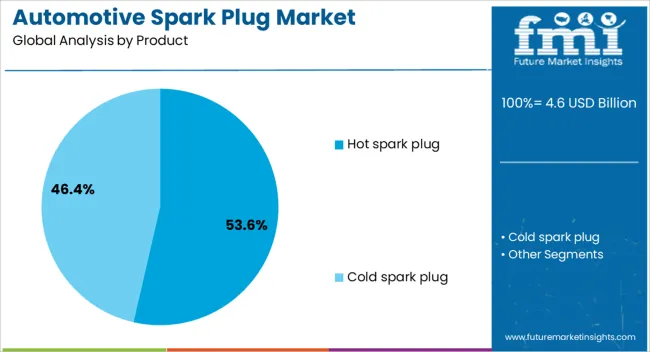
The hot spark plug segment is projected to hold 53.6% of the automotive spark plug market revenue in 2025, maintaining its position as the dominant product type. This segment’s growth is driven by its suitability for engines operating at lower speeds or with lower heat dissipation requirements, ensuring stable combustion and preventing fouling.
Hot spark plugs are preferred in certain engine designs for their ability to reach optimal operating temperatures quickly, improving cold start performance. The segment benefits from ongoing demand in both passenger vehicles and light commercial vehicles.
As engine designs continue to optimize for fuel economy and emissions, hot spark plugs remain an important component in many applications.

The copper electrode material segment is expected to account for 41.9% of the market revenue in 2025, securing its position as the leading electrode type. Copper electrodes offer excellent thermal conductivity which helps in efficient heat dissipation and stable spark formation.
Their cost-effectiveness and ease of manufacturing have kept them popular among automotive manufacturers. Although alternatives like iridium and platinum have entered the market, copper remains widely used especially in standard spark plugs for many vehicle segments.
The balance between performance and affordability ensures that the copper electrode segment retains significant demand.
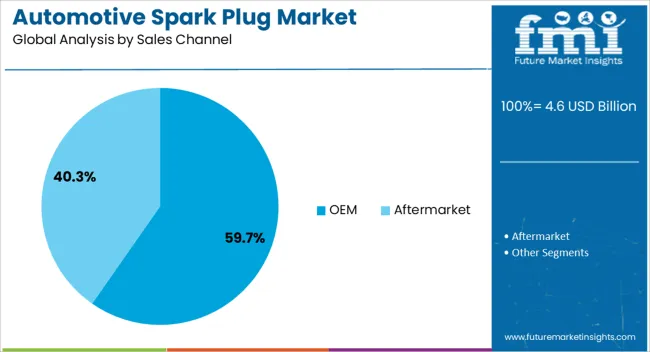
The OEM sales channel is projected to represent 59.7% of the automotive spark plug market revenue in 2025, leading the market. Growth in this segment is fueled by increasing vehicle production globally and the integration of spark plugs directly into new vehicles during manufacturing.
Automakers prioritize reliable and efficient components, which sustains OEM demand for high-quality spark plugs. Additionally, OEM channels provide consistent sales volume and support for emerging engine technologies.
The preference for OEM components also reflects consumer and regulatory focus on vehicle safety and performance standards. As vehicle production expands, the OEM sales channel is expected to remain the primary revenue contributor.
The automotive spark plug market has been expanding due to increasing demand for efficient ignition systems in gasoline-powered vehicles, hybrid cars, and high-performance engines. Spark plugs have been widely utilized to ensure reliable combustion, fuel efficiency, and lower emissions. Market growth has been supported by advances in precious metal electrodes, iridium and platinum coatings, and enhanced thermal designs. Rising vehicle production, stricter emission norms, and the shift toward performance optimization in engines have further strengthened the adoption of advanced automotive spark plugs globally.
The growing production of passenger cars, light commercial vehicles, and high-performance automobiles has been a primary driver for the automotive spark plug market. Spark plugs are essential in delivering precise ignition timing and ensuring complete fuel combustion, which enhances engine performance and fuel economy. Manufacturers have increasingly focused on optimizing engine designs to comply with efficiency standards, driving demand for advanced spark plugs with enhanced heat resistance and durability. In addition, hybrid vehicles and gasoline engines require reliable ignition solutions for smoother operation under varying conditions. The global expansion of automotive manufacturing hubs, particularly in Asia-Pacific and Europe, has further contributed to the steady rise in demand for spark plugs capable of supporting efficient, high-performance combustion systems across diverse vehicle segments.
Technological innovations in electrode materials, coatings, and design have strengthened the automotive spark plug market. Spark plugs with iridium, platinum, and double-platinum electrodes have been developed to improve durability, reduce wear, and maintain consistent ignition performance over extended engine life. Innovations in thermal management, such as optimized insulator designs and heat-dissipating structures, have allowed spark plugs to operate efficiently under extreme conditions. Laser welding, precision machining, and advanced ceramic insulators have further enhanced performance reliability. Multi-electrode and fine-wire designs have improved spark stability and fuel combustion efficiency. These technological advancements have made modern spark plugs capable of supporting cleaner emissions, better fuel economy, and higher engine efficiency, meeting the requirements of contemporary gasoline and hybrid vehicles worldwide.
Compliance with stringent emission regulations and fuel efficiency standards has been a significant factor driving adoption of advanced spark plugs. Automakers are required to meet regulatory norms for carbon monoxide, hydrocarbon, and nitrogen oxide emissions in gasoline engines. Spark plugs with high-precision electrodes and superior thermal conductivity have been implemented to ensure complete combustion, thereby reducing emissions and optimizing fuel use. Regulatory mandates have encouraged manufacturers to adopt long-life, high-performance spark plugs to maintain engine efficiency over the vehicle’s lifecycle. The focus on reducing the carbon footprint of vehicles and meeting global fuel economy standards has reinforced the need for spark plugs that combine durability, reliability, and environmental compliance in both passenger and commercial vehicles.
The increasing adoption of hybrid vehicles, high-performance cars, and luxury automobiles has created significant growth opportunities for the automotive spark plug market. Hybrid engines require spark plugs capable of handling variable operating cycles and start-stop functions while maintaining efficient ignition. Performance-oriented vehicles demand spark plugs with enhanced thermal resistance, high-voltage tolerance, and longer service life. Growth in emerging markets with rising disposable income and vehicle penetration has further supported demand for premium spark plugs. The aftermarket replacement and maintenance services continue to offer recurring opportunities. As the automotive industry continues to focus on fuel efficiency, emissions reduction, and engine performance, the adoption of advanced spark plug technologies is expected to expand globally across multiple vehicle segments.
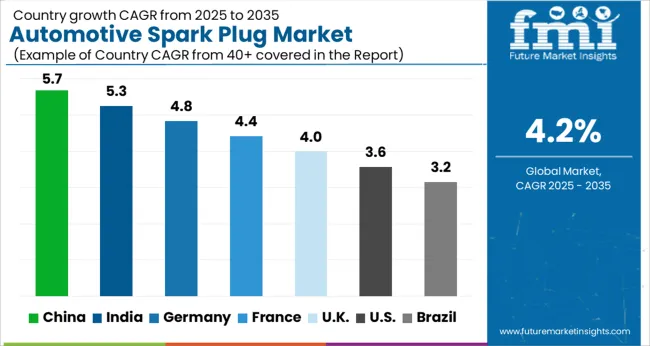
The market is projected to grow at a CAGR of 4.2% between 2025 and 2035, driven by increasing demand for vehicle engine efficiency, replacement components, and advanced ignition technologies. China is forecast to lead with a 5.7% CAGR, supported by the expansion of automotive manufacturing and adoption of high-performance spark plugs. India follows at 5.3%, with growth fueled by rising vehicle production and after-market replacement demand. Germany, at 4.8%, benefits from strong automotive engineering and precision manufacturing capabilities. The UK, growing at 4.0%, focuses on innovation in spark plug designs for efficiency improvements, while the USA, at 3.6%, experiences steady demand through engine maintenance and replacement cycles. This report includes insights on 40+ countries; the top markets are shown here for reference.
The industry in China is projected to expand at a CAGR of 5.7% from 2025 to 2035, supported by rising vehicle production and replacement demand. Domestic manufacturers are enhancing production capacities in Zhejiang and Jiangsu, focusing on high-performance spark plugs for passenger cars and commercial vehicles. Increasing adoption of gasoline-powered vehicles in tier 2 and tier 3 cities is boosting aftermarket demand. Investments in research and development for longer life and energy-efficient spark plugs are improving product quality and performance. Collaborations between automotive OEMs and component suppliers are strengthening the supply chain and accelerating market penetration.
The demand for automotive spark plugs in India is expected to grow at a CAGR of 5.3% over 2025 to 2035, driven by expansion in two-wheeler and passenger car production. Manufacturers are investing in modernized assembly lines in Maharashtra and Tamil Nadu to meet rising domestic and export demand. Government policies promoting local automotive component manufacturing are supporting growth. Increasing adoption of high-efficiency engines is driving demand for advanced spark plug technologies. Strategic partnerships with global suppliers are facilitating technology transfer and improving product quality.
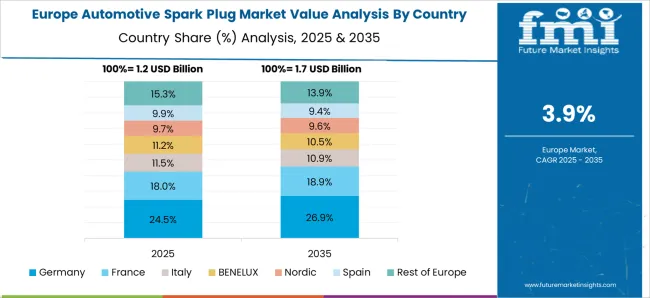
Germany is forecast to expand at a CAGR of 4.8% between 2025 and 2035, supported by premium vehicle production and technological innovations. Leading automotive OEMs are emphasizing spark plug optimization for performance and emission reduction. Investment in advanced manufacturing technologies is enhancing precision and reliability of spark plugs. The aftermarket segment continues to grow due to increased vehicle lifespan and maintenance cycles. Collaborations with international technology providers are promoting advanced spark plug materials and coatings.
The UK industry is expected to grow at a CAGR of 4.0% from 2025 to 2035, fueled by demand for replacement components in gasoline-powered vehicles. Manufacturers are expanding distribution networks to improve accessibility for service centers and aftermarket channels. Investment in testing and quality assurance ensures compliance with emission and safety regulations. Increasing consumer preference for durable and energy-efficient spark plugs is shaping market trends. Strategic collaborations with European suppliers are enhancing product offerings and supply reliability.
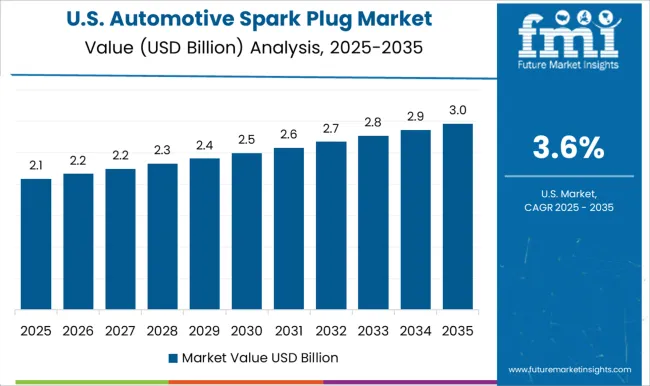
The United States automotive spark plug industry is projected to expand at a CAGR of 3.6% over 2025 to 2035, driven by vehicle maintenance and replacement cycles. OEMs and aftermarket suppliers are focusing on high-performance spark plugs for SUVs and light trucks. Investment in quality control and advanced materials is enhancing product reliability. Strategic partnerships with component manufacturers in Asia are ensuring supply consistency. The growth of hybrid gasoline vehicles is also promoting demand for specialized spark plugs with higher energy efficiency.
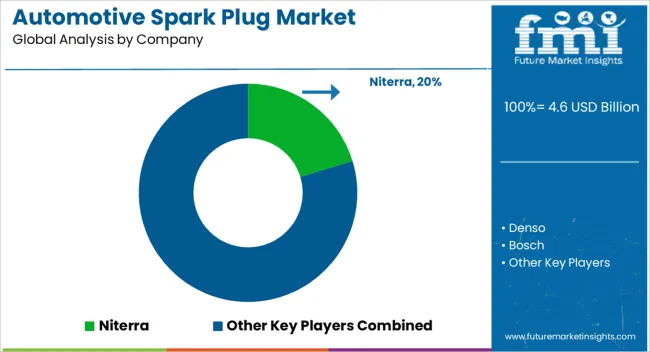
Niterra has established a strong presence globally, offering high-performance spark plugs tailored for passenger cars and commercial vehicles, backed by extensive R&D in material science. Denso continues to dominate through advanced iridium and platinum plug technologies, enhancing ignition efficiency and durability across diverse automotive applications. Bosch combines global distribution and innovative designs, delivering spark plugs for standard and high-performance vehicles while supporting OEM requirements.
Tenneco and Valeo focus on integrated engine components and emission-compliant spark plug solutions, targeting both replacement and new vehicle segments. Hyundai Mobis integrates spark plugs within comprehensive powertrain systems, strengthening its aftermarket and OEM reach. General Motors maintains in-house production for proprietary vehicle models, ensuring optimized engine compatibility and longevity. Specialized players such as Pulstar, Autolite, and Torquemaster Spark Plugs emphasize high-energy, performance-focused, and racing-oriented spark plugs, addressing niche and aftermarket demands.
Competition is driven by material innovation, precise manufacturing tolerances, and adherence to automotive emission standards, creating moderate entry barriers for new players, while established manufacturers continue to leverage global distribution networks, technological expertise, and strategic partnerships to retain market leadership.
| Item | Value |
|---|---|
| Quantitative Units | USD Billion |
| Product | Hot spark plug and Cold spark plug |
| Electrode Material | Copper, Platinum, Iridium, and Others |
| Sales Channel | OEM and Aftermarket |
| Vehicle | Passenger car, Commercial vehicle, and Two-wheeler |
| Regions Covered | North America, Europe, Asia-Pacific, Latin America, Middle East & Africa |
| Country Covered | United States, Canada, Germany, France, United Kingdom, China, Japan, India, Brazil, South Africa |
| Key Companies Profiled | Niterra Co., Ltd. (NGK), DENSO Corporation, Robert Bosch GmbH, Tenneco Inc. (Champion), Valeo S.A., Hyundai Mobis Co., Ltd., General Motors (ACDelco), Pulstar LLC, Autolite (First Brands Group), Torque Master. |
| Additional Attributes | Dollar sales by spark plug type and vehicle segment, demand dynamics across passenger cars, commercial vehicles, and two-wheelers, regional trends in production and adoption across North America, Europe, and Asia-Pacific, innovation in iridium and platinum coatings, multi-electrode designs, and enhanced thermal performance, environmental impact of fuel efficiency improvements, reduced emissions, and material recycling, and emerging use cases in hybrid and electric vehicle auxiliary engines, high-performance motorsport applications, and advanced ignition systems. |
The global automotive spark plug market is estimated to be valued at USD 4.6 billion in 2025.
The market size for the automotive spark plug market is projected to reach USD 6.9 billion by 2035.
The automotive spark plug market is expected to grow at a 4.2% CAGR between 2025 and 2035.
The key product types in automotive spark plug market are hot spark plug and cold spark plug.
In terms of electrode material, copper segment to command 41.9% share in the automotive spark plug market in 2025.






Our Research Products

The "Full Research Suite" delivers actionable market intel, deep dives on markets or technologies, so clients act faster, cut risk, and unlock growth.

The Leaderboard benchmarks and ranks top vendors, classifying them as Established Leaders, Leading Challengers, or Disruptors & Challengers.

Locates where complements amplify value and substitutes erode it, forecasting net impact by horizon

We deliver granular, decision-grade intel: market sizing, 5-year forecasts, pricing, adoption, usage, revenue, and operational KPIs—plus competitor tracking, regulation, and value chains—across 60 countries broadly.

Spot the shifts before they hit your P&L. We track inflection points, adoption curves, pricing moves, and ecosystem plays to show where demand is heading, why it is changing, and what to do next across high-growth markets and disruptive tech

Real-time reads of user behavior. We track shifting priorities, perceptions of today’s and next-gen services, and provider experience, then pace how fast tech moves from trial to adoption, blending buyer, consumer, and channel inputs with social signals (#WhySwitch, #UX).

Partner with our analyst team to build a custom report designed around your business priorities. From analysing market trends to assessing competitors or crafting bespoke datasets, we tailor insights to your needs.
Supplier Intelligence
Discovery & Profiling
Capacity & Footprint
Performance & Risk
Compliance & Governance
Commercial Readiness
Who Supplies Whom
Scorecards & Shortlists
Playbooks & Docs
Category Intelligence
Definition & Scope
Demand & Use Cases
Cost Drivers
Market Structure
Supply Chain Map
Trade & Policy
Operating Norms
Deliverables
Buyer Intelligence
Account Basics
Spend & Scope
Procurement Model
Vendor Requirements
Terms & Policies
Entry Strategy
Pain Points & Triggers
Outputs
Pricing Analysis
Benchmarks
Trends
Should-Cost
Indexation
Landed Cost
Commercial Terms
Deliverables
Brand Analysis
Positioning & Value Prop
Share & Presence
Customer Evidence
Go-to-Market
Digital & Reputation
Compliance & Trust
KPIs & Gaps
Outputs
Full Research Suite comprises of:
Market outlook & trends analysis
Interviews & case studies
Strategic recommendations
Vendor profiles & capabilities analysis
5-year forecasts
8 regions and 60+ country-level data splits
Market segment data splits
12 months of continuous data updates
DELIVERED AS:
PDF EXCEL ONLINE
Spark Plug Market Growth – Trends & Forecast 2024 to 2034
Spark Plug Accessories Market
Automotive Sparking Cable Market Size and Share Forecast Outlook 2025 to 2035
Iridium Spark Plug Market Size and Share Forecast Outlook 2025 to 2035
Automotive Direct Liquid Cooling IGBT Module Market Size and Share Forecast Outlook 2025 to 2035
Automotive Hoses and Assemblies Market Size and Share Forecast Outlook 2025 to 2035
Automotive Network Testing Market Size and Share Forecast Outlook 2025 to 2035
Automotive Performance Part Market Size and Share Forecast Outlook 2025 to 2035
Automotive Carbon Ceramic Brake Market Size and Share Forecast Outlook 2025 to 2035
Automotive Camshaft Market Size and Share Forecast Outlook 2025 to 2035
Automotive Stamping Industry Analysis in India Size and Share Forecast Outlook 2025 to 2035
Automotive Cylinder Liner Market Size and Share Forecast Outlook 2025 to 2035
Automotive Microcontroller Market Size and Share Forecast Outlook 2025 to 2035
Automotive Roof Rails Market Size and Share Forecast Outlook 2025 to 2035
Spark Detection System Market Forecast and Outlook 2025 to 2035
Automotive Active Safety System Market Size and Share Forecast Outlook 2025 to 2035
Automotive Diagnostic Scan Tool Market Size and Share Forecast Outlook 2025 to 2035
Automotive Test Equipment Market Size and Share Forecast Outlook 2025 to 2035
Automotive Dynamic Map Data Market Size and Share Forecast Outlook 2025 to 2035
Automotive Green Tires Market Size and Share Forecast Outlook 2025 to 2035

Thank you!
You will receive an email from our Business Development Manager. Please be sure to check your SPAM/JUNK folder too.
Chat With
MaRIA